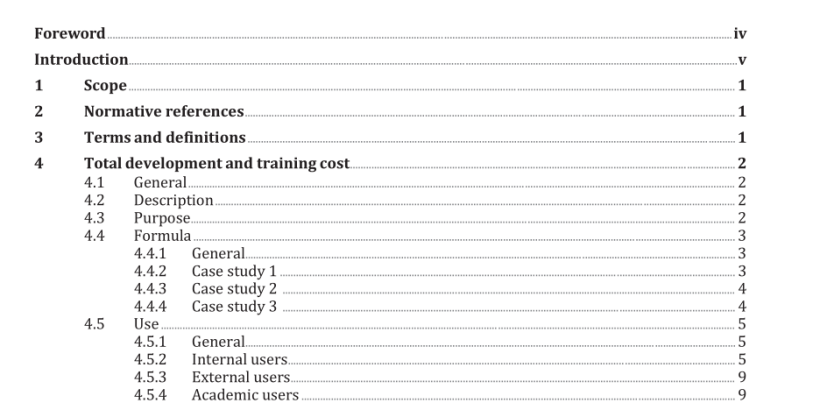ISO/TS 30428:2021 pdf download – Human resource management — Skills and capabilities metrics cluster.
4.1 General Development and training are used to increase the skills and capabilities of the workforce to help an organization accomplish its mission, achieve its goals and meet its needs. Many organizations make significant investments in development and training, and the total development and training cost is an important measure of an organization’s investment in human capital. While cost is an input metric, it is nonetheless an indicator of the organization’s commitment to invest in its workforce, and some research has shown a correlation to better financial performance. ISO 30414 recommends this metric be reported internally and externally by all organizations.
4.2 Description Total development and training cost is the sum of all spending on training and development within an organization. Total cost includes items such as salaries and benefits for the staff, overhead costs (such as supplies), direct costs of conducting the training (such as room rental, materials and travel cost for staff), costs for external suppliers [developers, facilitators, learning management system (LMS) providers] and tuition assistance. NOTE 1 This list is just meant to provide examples of costs to be included. This document calls for all reported training costs to be included. In practice this is measured as the sum of all spending by the internal training departments and the amount spent on tuition assistance for employees to obtain certificates or degrees. If data are available on training expenditures by other departments (not captured by the training departments), this should be added for a more complete picture. It does not include spending on training-related conferences hosted by other organizations or the travel expenditures for non-training department employees to attend training. It also does not include the opportunity cost (value of the time spent in training) of the participants in the training. NOTE 2 Others have defined total cost to include opportunity cost, so it is important to know which definition is being used when benchmarking or comparing to another organization. The addition of opportunity costs produces a more accurate measure of total cost.
4.4.1 General Total development and training cost is simply the sum of all spending on training and development by an organization. The operational formula is: Total development and training cost = sum of spending by all training departments within the organization + sum of spending on training by other departments not already captured by the training departments (if available) + sum of spending on tuition assistance for certificate or degree programmes. In practice, data for the first part of the formula should be readily available for any organization that has one or more training departments. Most of the spending on training and development should be captured in the training departments ’ expense statements. Some organizations are too small to have a dedicated training department and, in this case, there can be an expense line item for training which can be used. Even in organizations with a training department, it is not uncommon for spending on training to occur outside the training departments. Often, units send their employees to training outside the organization and this training is not typically captured by the training department. If data on these outside expenditures is available, it should be added. Tuition assistance can be managed by the training department, a different HR function or the business units. Total development and training cost should be calculated using the most aggregated data available. Start with the departmental expense statements for the training departments which should include all the costs associated with providing the training, including staff expenses, overheads (e.g. room rental, materials, travel, consultants, vendors, LMS), and internal charges (e.g. some organizations charge their training departments for space, HR, IT). Starting with aggregate costs is much easier and more accurate than trying to build up the cost of training on a programme-by-programme basis.
